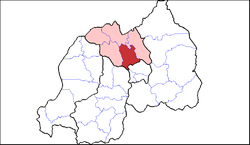Rulindo District
Rulindo is a district (akarere) in Northern Province, Rwanda. Its capital is Tare (also known as Bushoki).
Rulindo District | |
|---|---|
 Shown within Northern Province and Rwanda | |
| Country | Rwanda |
| Province | Northern |
| Capital | kinini |
| Area | |
| • Total | 567 km2 (219 sq mi) |
| Population (2012 census) | |
| • Total | 287,681 |
| • Density | 510/km2 (1,300/sq mi) |
Geography
The district lies roughly halfway between Kigali and Ruhengeri, and is very mountainous, containing Mount Kabuye. Its principal town, Tare (more commonly known as Nyirangarama), serves as a rest and refreshment stop for most long distance bus services between Kigali and Gisenyi and Goma.
Economy

A farmer in Rulindo
Rulindo district is home to Agashya, Rwanda's leading manufacturer of passion fruit squash. Kinihira Sector is home to the Sorwathe Tea Factory.
Sectors
Rulindo district is divided into 17 sectors (imirenge): Base, Burega, Bushoki, Buyoga, Cyinzuzi, Cyungo, Kinihira, Kisaro, Masoro, Mbogo, Murambi, Ngoma, Ntarabana, Rukozo, Rusiga, Shyorongi and Tumba.
gollark: I was unsure which it was.
gollark: Oh, Bellard, oops.
gollark: ddg! Ballard quickjs
gollark: Why not use Ballard's QuickJS?
gollark: This is quite possibly the most ethical trolley problem.
References
- "Districts of Rwanda". Statoids.
- Inzego.doc — Province, District and Sector information from MINALOC, the Rwanda ministry of local government.
This article is issued from Wikipedia. The text is licensed under Creative Commons - Attribution - Sharealike. Additional terms may apply for the media files.